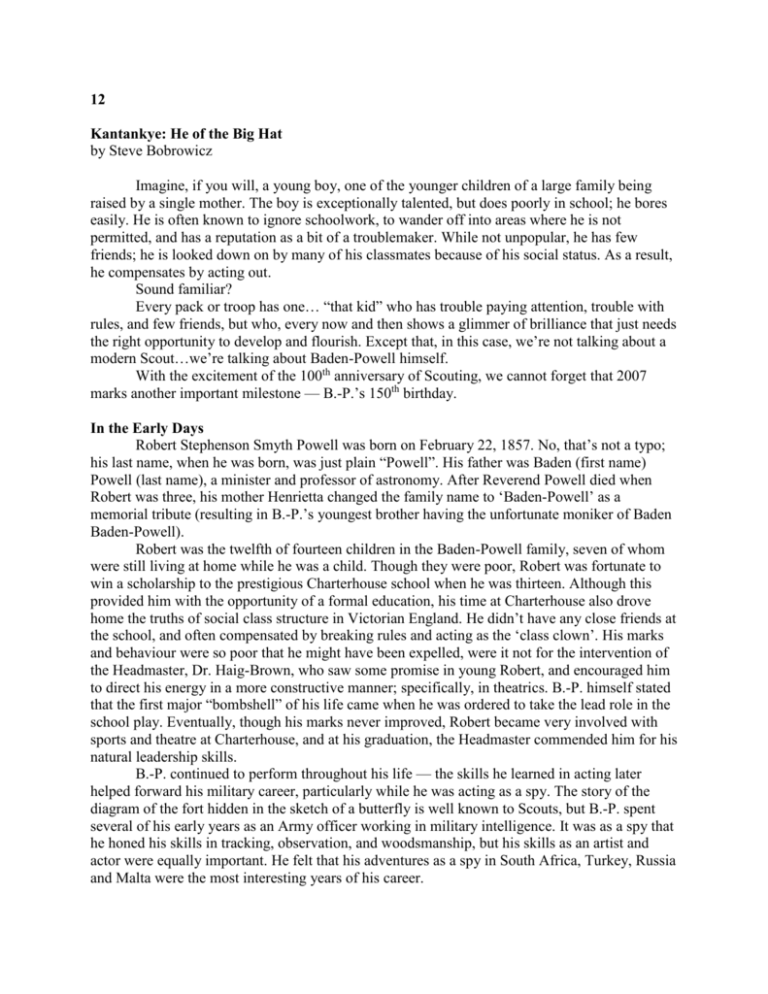Imagine, if you will, a young boy, one of the younger
advertisement

12 Kantankye: He of the Big Hat by Steve Bobrowicz Imagine, if you will, a young boy, one of the younger children of a large family being raised by a single mother. The boy is exceptionally talented, but does poorly in school; he bores easily. He is often known to ignore schoolwork, to wander off into areas where he is not permitted, and has a reputation as a bit of a troublemaker. While not unpopular, he has few friends; he is looked down on by many of his classmates because of his social status. As a result, he compensates by acting out. Sound familiar? Every pack or troop has one… “that kid” who has trouble paying attention, trouble with rules, and few friends, but who, every now and then shows a glimmer of brilliance that just needs the right opportunity to develop and flourish. Except that, in this case, we’re not talking about a modern Scout…we’re talking about Baden-Powell himself. With the excitement of the 100th anniversary of Scouting, we cannot forget that 2007 marks another important milestone — B.-P.’s 150th birthday. In the Early Days Robert Stephenson Smyth Powell was born on February 22, 1857. No, that’s not a typo; his last name, when he was born, was just plain “Powell”. His father was Baden (first name) Powell (last name), a minister and professor of astronomy. After Reverend Powell died when Robert was three, his mother Henrietta changed the family name to ‘Baden-Powell’ as a memorial tribute (resulting in B.-P.’s youngest brother having the unfortunate moniker of Baden Baden-Powell). Robert was the twelfth of fourteen children in the Baden-Powell family, seven of whom were still living at home while he was a child. Though they were poor, Robert was fortunate to win a scholarship to the prestigious Charterhouse school when he was thirteen. Although this provided him with the opportunity of a formal education, his time at Charterhouse also drove home the truths of social class structure in Victorian England. He didn’t have any close friends at the school, and often compensated by breaking rules and acting as the ‘class clown’. His marks and behaviour were so poor that he might have been expelled, were it not for the intervention of the Headmaster, Dr. Haig-Brown, who saw some promise in young Robert, and encouraged him to direct his energy in a more constructive manner; specifically, in theatrics. B.-P. himself stated that the first major “bombshell” of his life came when he was ordered to take the lead role in the school play. Eventually, though his marks never improved, Robert became very involved with sports and theatre at Charterhouse, and at his graduation, the Headmaster commended him for his natural leadership skills. B.-P. continued to perform throughout his life — the skills he learned in acting later helped forward his military career, particularly while he was acting as a spy. The story of the diagram of the fort hidden in the sketch of a butterfly is well known to Scouts, but B.-P. spent several of his early years as an Army officer working in military intelligence. It was as a spy that he honed his skills in tracking, observation, and woodsmanship, but his skills as an artist and actor were equally important. He felt that his adventures as a spy in South Africa, Turkey, Russia and Malta were the most interesting years of his career. As B.-P. advanced in rank in the Army, his duties shifted from intelligence and spying to commanding troops. After participating in British campaigns against the Zulu, Ashanti and Matabele in Africa, and duty in India and Afghanistan, the real turning point in B.-P.’s career came when he was assigned to command the British North-west Frontier Forces in South Africa. Defence of Mafeking Trouble was brewing amongst the Boers (South Africans of Dutch descent), and B.-P. was assigned the task of raising and equipping a military force on the frontier, without raising suspicion from the Boers. It was this role that found him in command of the military garrison at the frontier town of Mafeking in October, 1899. When the Boers declared war on October 11, 1899, Mafeking was one of their first objectives because of its importance to the railway. Baden-Powell and his small garrison of about 1000 men held off the Boer siege for 217 days, largely through ingenuity and clever bluffing, building makeshift supplies out of whatever was on hand, and devising ways to trick the enemy into thinking that the British troops were better equipped than was actually the case. The famous Mafeking Cadet Corps were formed during the siege by B.-P.’s Chief Staff Officer, Major Lord Edward Cecil. In order to free up soldiers to fight on the line, the Cadets, comprised of all British boys over the age of nine, assumed many of the non-combat duties in the garrison, primarily acting as messengers and watchmen. It was dangerous duty; the defence of Mafeking comprised of trenches and outposts spread out over several miles around the town and native villages. The cadets were required to deliver messages to the outposts on donkeys and bicycles, often coming under artillery fire. The Cadets’ bravery and dedication to duty impressed B.-P. greatly, and he took it upon himself to teach them skills important to military scouting — woodmanship, camping, hiking, etc. The defence of Mafeking made Baden-Powell a celebrity on the same level of the popstars and professional athletes of today. After Mafeking was relieved in May, 1900, B.-P.’s image began showing up on souvenirs ranging from postcards to dinner plates. On his return to London, he was mobbed by adoring fans. It was this fame that made Scouting possible. During the siege, B.-P. put the finishing touches on a little book that he had written, entitled Aids to Scouting. It wasn’t the first book that he had written on topics such as tracking, observation and woodsmanship, but his new-found fame made it an instant best-seller, among soldiers and civilians alike. After Mafeking, B.-P. was assigned to establish a military police force in South Africa. The South African Constabulary (SAC) acted in a similar role to Canada’s North-West Mounted Police (NWMP); part soldier, part frontier police force. In fact, B.-P. recruited Sam Steele, former superintendent of the NWMP, to command one of the SAC’s divisions. He liked Steele’s Stetson hat so much that he ordered 10,000 of them for the SAC…and later adopted them for the Boy Scouts. Because of his Stetson, the Ashanti called him Kantankye (He of the Big Hat). Scouting Begins In 1906, B.-P. began to develop his “Boy Scout Scheme”, soliciting input from prominent military figures and educators. The Scheme, intended for use primarily by the Boys’ Brigade, Church Lads League and YMCA as supplementary material for their existing programs, integrated much of the content of Aids to Scouting into a more age-appropriate book that he was writing. The content of the new book was enhanced with ideas borrowed from other youth educators, notably Canadian naturalist Ernest Thompson Seton (who went on to become the first commissioner of the Boy Scouts of America). B.-P. had developed much of the theory of the Scheme, but needed a practical test before he had his new book published. It was for this purpose that in August, 1907, Baden-Powell, assisted by Major MacLaren (remember the MacLaren tartan on the Gilwell neckerchief?), took twenty boys (plus B.-P.’s nephew Donald) to Brownsea Island, in Poole Harbour, England. For two weeks, the boys, organized in four Patrols, camped and lived according to the Scheme that B.-P. had laid out in the draft of his new book. The experiment was a great success; the only noteworthy disappointment among the boys being that General Baden-Powell didn’t wear his famous hat. Over the next few months, B.-P. made some revisions to his draft handbook, based on his experiences on Brownsea. Scouting for Boys, originally published in eight fortnightly instalments, made its first appearance in January, 1908. The rest, they say, is history. - Scouter Steve Bobrowicz is a Scouting history enthusiast and Group Commissioner for 1st Manitouwadge in Northern Ontario. Sidebars: Did you know… The style of hat worn by the South African Constabulary (and later the Boy Scouts) was originally called the “Boss of the Plains”. When General Baden-Powell placed his order for hats from the Stetson company, they were delivered under the label ‘Hats, B.P. pattern’. Coincidence perhaps, but the name stuck. Baden-Powell borrowed heavily from Rudyard Kipling’s Jungle Books and Kim for some components of Scouting, particularly in the development of the Wolf Cub program. B.-P. wasn’t just a fan of Kipling…they were neighbours. In fact, Kipling’s son participated in B.-P.’s second experimental Scout camp at Humshaugh, in 1909. Among his numerous honours and awards, B.-P. held honourary degrees from the University of Toronto and McGill University in Montreal. Most Gilwellians today wear two Woodbadge beads; Woodbadge trainers wear three or four. Baden-Powell held the exclusive right to grant a fifth bead; he wore six himself. In addition to acting, B.-P. was also a prolific writer and artist. In all, he wrote 37 books, as well as numerous pamphlets and articles. He was ambidextrous; writing and drawing equally well with both hands. Scouting for Boys is the second best selling English language book of all time, after the King James Bible. Interesting Reading Twenty-one Years of Scouting: The Official History of the Boy Scout Movement From Its Inception by E.K. Wade. C. Arthur Pearson Ltd., 1929. Lessons From the Varsity of Life by Lord Baden-Powell. C. Arthur Pearson Ltd., 1933. [this is B.-P.’s autobiography and is a fantastic read] Baden-Powell by R.H. Kiernan. George G. Harrap & Co. Ltd., 1939. Baden-Powell: The Man Who Lived Twice by Mary Drewery. Hodder and Stroughton Ltd., 1975. Hi Rick, Two pictures, Photos: Archives 12BP Major General 1900 Powell in 1900. Cutline: Kantankye: He of the Big Hat. Major General Baden- 12Mafeking Cadets Cutline: Boys aged nine years old and older formed the Mafeking Cadets, playing a large part in helping to withstand the siege for 217 days.







